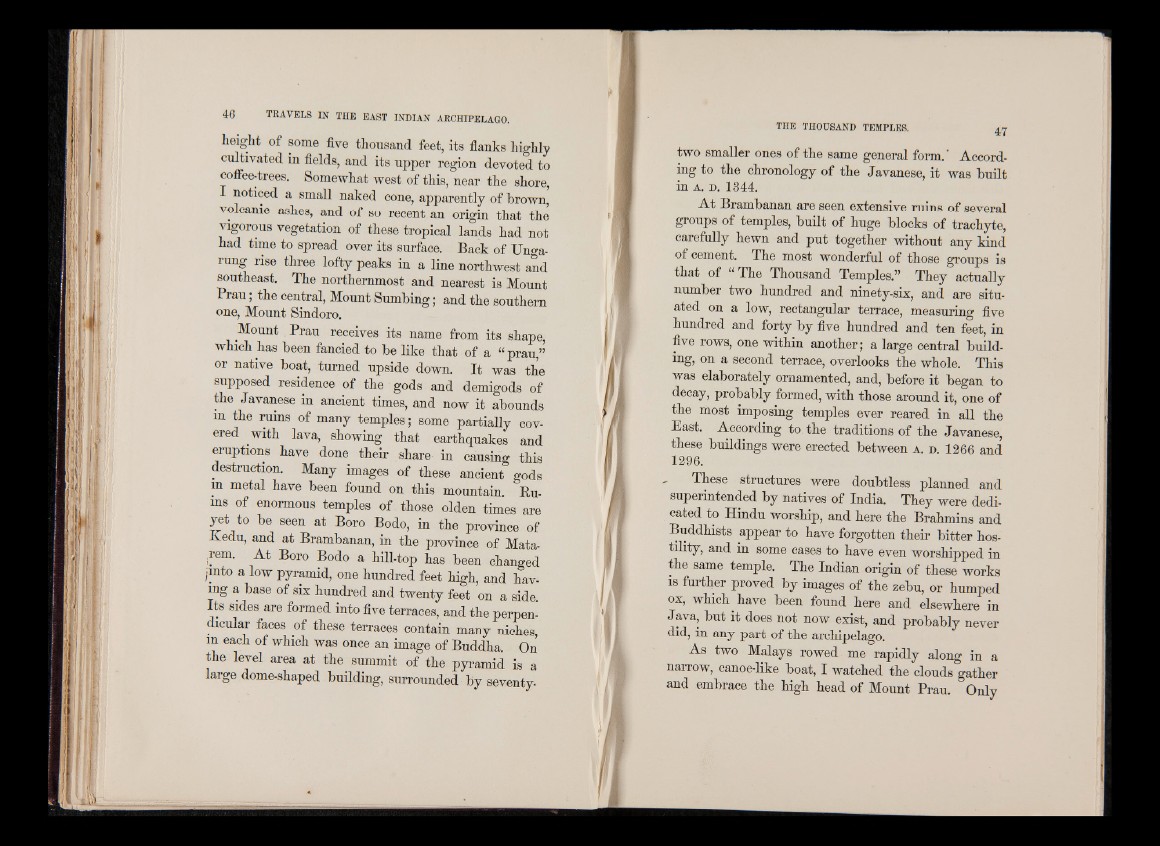
height of some five thousand feet, its flanks highly
cultivated in fields, and its upper region devoted to
coffee-trees. Somewhat west of this, near the shore,
I noticed a small naked cone, apparently of brown,
volcanic ashes, and of so recent an origin that the
vigorous vegetation of these tropical lands had not
had time to spread over its surface. Back of Unga-
rung rise three lofty peaks in a line northwest and
southeast. The northernmost and nearest is Mount
Prau; the central, Mount Sumbing; and the southern
one, Mount Sindoro.
Mount Prau receives its name from its shape,
which has been fancied to be like that of a “ prau,’’
or native boat, turned upside down. It was the
supposed residence of the gods and demigods of
the Javanese in ancient times, and now it abounds
in the ruins of many temples; some partially covered
with lava, showing that earthquakes and
eruptions have done their share in causing this
destruction. Many images of these ancient gods
in metal have been found on this mountain. Burns
of enormous temples of those olden times are
yet to be seen at Boro Bodo, in the province of
Kedu, and at Brambanan, in the province of Mata-
,rem. At Boro Bodo a hill-top has been changed
jmto a low pyramid, one hundred feet high, and having
a base of six hundred and twenty feet on a side.
Its sides are formed into five terraces, and the perpendicular
faces of these terraces contain many niches,
in each of which was once an image of Buddha. On
the level area at the summit of the pyramid is a
large dome-shaped building, surrounded by seventy.
two smaller ones of the same general form. ‘ According
to the chronology of the Javanese, it was built
in a . d . 1344.
At Brambanan are seen extensive rums of several
groups of temples, built of huge blocks of trachyte,
carefully hewn and put together without any kind
of cement. The most wonderful of those groups is
that of “ The Thousand Temples.” They actually
number two hundred and ninety-six, and are situated
on a low, rectangular terrace, measuring five
hundred and forty by five hundred and ten feet, in
five rows, one within another; a large central building,
on a second terrace, overlooks the whole. This
was elaborately ornamented, and, before it began to
decay, probably formed, with those around it, one of
the most imposing temples ever reared in all the
East. According to the traditions of the Javanese,
these buildings were erected between a . d . 1266 and
1296.
" These structures were doubtless planned and
superintended by natives of India. They were dedicated
to Hindu worship, and here the Brahmins and
Buddhists appear to have forgotten their bitter hos-
tility, and in some cases to have even worshipped in
the same temple. The Indian origin of these works
is further proved by images of the zebu, or humped
ox, which have been found here and elsewhere in
Java, but it does not now exist, and probably never
did, in any part of the archipelago.
As two Malays rowed me rapidly along in a
narrow, canoe-like boat, I watched the clouds gather
and embrace the high head of Mount Prau. Only